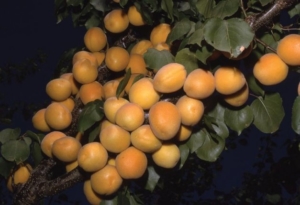
Apricots
Only time will tell how bad it is, but growers up and down the West Coast are finding some damage to stone fruit and cherries caused by cold weather in late February. They will be better able to assess losses after bloom and as fruit matures.
“As we always say until it’s too late, it’s too early to tell,” quipped Mike Collins, California cherry category manager of Stemilt Growers and part of the state’s crop estimation team.
Between Feb. 19 and 23, temperatures reached lows in the 20s in California after a few weeks of highs above 70 that seemed to have the industry headed toward a very early spring. Washington followed a similar pattern, as overnight lows dipped into the low teens in places during the same time frame after highs reached nearly 70 earlier in the month.
With cherries, most varieties had yet to bloom when the freeze happened, Collins said. “Fortunately, most, if not nearly all orchards had not reached the most vulnerable stage of danger during the frost events,” he said.
However, few places in California’s vast Central Valley escaped problems completely, said Bruce Frost, a Bakersfield area cherry grower. Damage varies from block to block depending on variety, elevation and rootstock.
“We’ll know a lot more about the first of April,” he said.
Frost suspects the lack of winter chill throughout the winter may cause more losses than the freeze, he said. To thrive, cherry trees need a certain number of days of dormancy each winter, something they don’t get in mild weather.
Growers in California’s early blooming districts estimate 10 percent damage on the early blooming varieties of Brooks and Tulare near Arvin, California, said B.J. Thurlby, president of the Washington State Fruit Commission in Yakima, Washington. He made several phone calls to California producers earlier this week to update the commissioners in one of their quarterly meetings. The Fruit Commission owns the Good Fruit Grower.
Mid-season districts near Kingsburg and Hanford got hit the worst with up to 30 percent damage, especially on the Royal series of varieties, Thurlby said. However, most Bings have appeared to survive the frost scare with 10 percent or less damage in orchards.
California growers typically plant varieties that bloom, and therefore harvest, earlier than the more productive regions in Oregon and Washington to reach the market first.
This year, bloom is about three to five days behind usual, said Thurlby. Growers anticipate harvest beginning April 20, and the crop may overlap some with the Northwest’s, but nothing out of the ordinary, they told him. Overall, growers expect the California crop to be smaller than last year’s 9.7 million 20-pound boxes.
California stone fruit
The cold also had some effect on California stone fruits, such as apricots, peaches and nectarines, which bloom even earlier than cherries, though it’s unclear how much.
However, some stone fruit orchards were in bloom during the cold snap, said George Radanovich, president of the California Fresh Fruit Association. That likely affected both the buds and the bees.
“While cold temperatures like the ones we saw two weeks ago, are not preferred, it is still too early to say whether we expect any loss in stone fruit,” Radanovich said. “We have heard from multiple commodities that there has been a noticeable lack of pollinator activity in orchards due to the cold weather.”
Some places received 2 to 3 inches of hail and 25-degree temperatures, said Frank Bavaro, who has cling peach orchards in San Joaquin and Stanislaus counties north of Modesto.
He expects to have little damage. “We were barely starting to push (buds),” he said. “We were at basically zero to 25 percent bloom.”
In one quirky twist, the weather rearranged schedules for him and many growers. Unless patterns change, he plans to harvest this year after growers in Marysville nearly 100 miles north. It’s usually the other way around.
In Washington …
Cherries were too far from bloom in Washington and Oregon at the time of the bad weather, but some of the region’s stone fruit growers have noticed damage. Of peaches, nectarines and apricots, apricots bloom earliest and were therefore the most susceptible.
Douglas Fruit growers in the Columbia Basin have some apricot blocks with up to 20 percent damage, said co-owner David Douglas, but he doesn’t know yet if it will reduce the overall crop. Growers typically thin to manage crop load and fruit size anyway.
“At this point nobody’s super concerned,” he said.
His growers were starting to see buds in early February, and were just about ready to begin their spring spraying before the cold snap.
Certain nectarine varieties also suffered minor damage but he has heard of no peach problems.
Some of Gilbert Orchards’ apricot blocks have up to 50 percent kill in isolated places where the company makes less effort to protect buds, said Dan Keller, the company’s orchard manager.
“In our point of view, we need to see a little bit of damage before spending money on oil,” he said.
Wind machines typically cover the center of orchards and only help if temperatures are close to the freezing point. Oil-burning heaters can protect edges and are more necessary if temperatures are in the mid-20s or below.
The losses have the potential to reduce the overall crop load, but he’s not sure yet, he said. Either way, this has not been a normal year.
“Having a significant amount of freeze damage this time of year has not been normal for the last 10 years or so,” he said.
By Ross Courtney






Leave A Comment